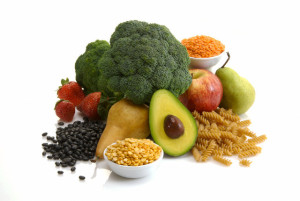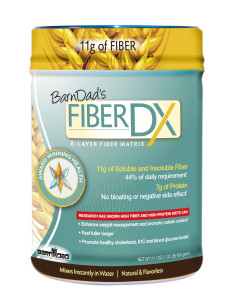Recent Posts
Archives
Categories
Monthly Archives: November 2011
Health Boost From New Forms Of Dietary Fiber
High-fiber foods are on the way to becoming tastier and more appealing to consumers thanks to new types of dietary fiber now under development. These consumer friendlier forms of fiber, which could be a boon to health, are the topic of an article in the current issue of Chemical & Engineering News (C&EN), ACS’ weekly newsmagazine.
C&EN Associate Editor Jyllian Kemsley notes that dietary fiber plays key roles in human health. Fiber creates a feeling of fullness that can reduce calorie intake, and provides an energy source for beneficial bacteria in the digestive tract. Studies link high fiber diets to a reduced risk of diseases such as diabetes and colon cancer. However, Americans on average eat only about 15 grams of fiber per day, barely half the recommended amount. Getting consumers to eat more fiber can be difficult, particularly when people find some high-fiber foods unpalatable, Kemsley notes.
Scientists and food manufacturers are hoping that a new type of food fiber, called digestion-resistant starch, will help boost fiber intake without agitating the palate. Some scientists are trying to produce these new fibers by heating or chemically altering existing starches. Others are focusing on engineering plants, such as wheat and rice, so that they can produce these fibers naturally. One study found that when a group of men ate pieces of white bread containing a form of the new fiber, their blood glucose and insulin levels dropped by nearly half.
ARTICLE: “New Fibers for Foods”
Source:
Michael Bernstein
American Chemical Society
BarnDad’s FiberDX®
The Wall Street Journal recently said – “People who consumed higher amounts of fiber, particularly from grains, had a significantly lower risk of dying over a nine-year period compared to those who consumed lower amount of fiber.”
We are not claiming BarnDad’s FiberDX® is a “cure-all” BUT if you want to lose weight without sacrificing all the foods you love and are looking for a simpler and more effective way to lose weight, manage lean muscle maintenance, and help to control your AIC, then BarnDad’s FiberDX® is just what you’ve been looking for! And it works for everyone to some capacity!
BarnDad’s FiberDX® is a 100% natural, time release, soluble and insoluble fiber matrix that naturally reduces hunger and supports healthy weight management, lean muscle and a healthy digestive system. Originally developed in Germany, where it was used to successfully treat diabetic and obese patients, BarnDad’s FiberDX® reduces hunger and slows the digestion and absorption of sugars and carbohydrates. This helps reduce insulin spikes and allows glucose to be metabolized more effectively.
BarnDad’s FiberDX® also supports heart health.It’s long been clinically proven that a diet high in fiber helps reduce cholesterol and triglycerides, which has a positive impact on the body’s mechanisms for regulating healthy cholesterol production. Health experts recommend a healthy diet include a minimum of 25 grams or more of fiber per day. One serving of BarnDad’s FiberDX® provides 11 grams of Fiber, a full 44 PERCENT of your daily fiber requirement.
While many single fiber products or supplements (imbalanced blends) often cause bloating, BarnDad’s FiberDX® patent-pending, eight-layer fiber matrix, works in days to provide consumers all the benefits of a high fiber diet without the negative side effects.
BarnDad’s FiberDX® is a flavorless,universal ingredient that easily mixes with water or other beverages and can also be used in baking as a flour substitute, resulting in healthy and delicious meals,snacks and desserts. BarnDad’s FiberDX® is the ultimate fiber supplement for optimum health, peak performance and vitality at any age.
The unique formula helps you feel pleasantly full,before you’ve had a chance to eat too much,and keeps you from getting hungry between meals. Simply take BarnDad’s FiberDX® 15 minutes before your regular meals,with water or a healthy beverage of your choice, and begin to look and feel better,while you continue to enjoy your favorite foods!
Read more about how BarnDad’s FiberDX® can help you look and feel the way you’ve always wanted.
These statements have not been evaluated by the Food and Drug Administration. This product is not intended to diagnose, treat, cure or prevent any disease.
Fiber May Keep You Healthier, Longer
Fiber May Keep You Healthier, Longer
Increased dietary intakes of fiber are associated with lower risks of dying from cardiovascular, infectious, and respiratory diseases, suggests data from the US National Cancer Institute.
The highest intakes of fiber – equivalent to about 30 grams per day for men and 25 grams for women – were associated with a reduction in the risk of dying from cardiovascular, infectious, and respiratory diseases of up to 60 percent, according to findings published in the Archives of Internal Medicine .
“Interestingly, our study found that dietary fiber intake, especially from grains , was inversely associated with the risk of death from infectious and respiratory diseases,” wrote researchers, led by Yikyung Park, ScD.
“Inflammation, a predominant pathphysiologic response in many infectious and respiratory diseases, has been suggested to contribute the progression of these diseases [and] studies have shown that dietary fiber has anti-inflammatory properties:
“The anti-inflammatory properties of dietary fiber could explain, in part, significant inverse associations of dietary fiber intake with infectious and respiratory diseases as well as with CVD death,” they added.
Fiber intakes
A 2008 International Food Information Council survey found 77 percent of people are proactively trying to consume additional fiber.
Despite such good intentions, however, many Americans only achieve about 50 percent of their recommended amount of 25 to 30 grams of fiber daily.
Packaged Facts estimates that in 2004, 91 percent of all fiber food ingredient sales were of conventional, insoluble-type fibers, which contains cellulose, hemicellulose and lignin and cannot be dissolved in water.
The remaining 9 percent share was split evenly between conventional, soluble-type fibers and emerging, novel fibers. The market researcher projects that insoluble fibers will decrease to 53.3 percent by 2014, while the share for the mostly new or newly refined conventional, soluble-type fibers will decrease slightly to 7.4 percent.
New data
The new study’s findings support the recommendations for intakes, with consumption of between 25 and 30 grams linked to lower risks of dying from a range of diseases.
The National Cancer Institute analyzed data from 219,123 men and 168,999 women participating in the NIH (National Institutes of Health)-AARP Diet and Health Study. Dietary intakes were assessed using food frequency questionnaires.
Over the course of about 9 years of study, 11,330 deaths in women and 20,126 deaths in men were documented.
After crunching the numbers, the researchers found that people with the highest average intakes – between 25 and 30 grams of fiber per day – had a 22 percent lower risk of death from all the causes.
For men, the highest intakes were associated with a reduction in the risk of death from cardiovascular, infectious, and respiratory diseases ranging from 34 to 59 percent in women and 24 to 56 percent in men.
The strongest associations were observed for fiber from grains and no from other sources, added the NCI researchers.
“Our study shows that dietary fiber may reduce the risk of premature death from all causes, especially from CVD and infectious and respiratory diseases,” wrote Dr Park and colleagues.
“The current Dietary Guidelines for Americans recommend choosing fiber-rich fruits, vegetables, and whole grains frequently and consuming 14 g/1000 calories of dietary fiber. A diet rich in dietary fiber from whole plant foods may provide significant health benefits,” they concluded.
Source: Archives of Internal Medicine
Published online ahead of print, doi:10.1001/archinternmed.2011.18
“Dietary Fiber Intake and Mortality in the NIH-AARP Diet and Health Study”
Authors: Y. Park, A.F. Subar, A. Hollenbeck, A. Schatzkin
Soluble Fiber Appears Key to Trimming ‘Bad Fat’
For every 10-gram daily increase, belly fat cut by nearly 4 percent over five years, researchers say
FRIDAY, July 1 (HealthDay News) — Increasing daily soluble fiber intake may help you lose dangerous visceral fat, which produces hormones and other substances linked to a host of chronic diseases, according to a new study.
Unlike the subcutaneous fat found just under the skin, visceral fat is located deep in the belly and wraps around a person’s vital organs. Researchers at Wake Forest Baptist Medical Center found the way to hone in on this deep belly fat is to get moderate amounts of regular exercise and to eat more soluble fiber from vegetables, fruits and beans.
“We know that a higher rate of visceral fat is associated with high blood pressure, diabetes and fatty liver disease,” said the study’s lead researcher, Dr. Kristen Hairston, assistant professor of internal medicine at Wake Forest Baptist in a news release from the medical center. “Our study found that making a few simple changes can have a big health impact.”
Researchers analyzed 1,114 black and Hispanic Americans since those populations are at higher risk for high levels of visceral fat as well as developing high blood pressure and diabetes. The study, published in the June 16 online issue of the journal Obesity , examined whether certain lifestyle factors, such as diet and exercise habits, were associated with a change in the participants’ belly fat over a period of five years.
Using CT scans to measure subcutaneous and visceral fat, researchers found that increased intake of soluble fiber was associated with a reduction in belly fat, but not subcutaneous fat.
In fact, for every 10-gram increase in soluble fiber eaten per day, visceral fat was reduced by 3.7 percent over five years. In addition, regular moderate exercise (30 minutes of vigorous exercise two to four times per week) resulted in a 7.4 percent reduction over the same time period.
So what exactly does a person need to eat to get 10-grams of soluble fiber each day? The researchers noted this could be achieved by eating two small apples, one cup of green peas and one-half cup of pinto beans daily.
The study pointed out, however, that more research is needed to explain the link between soluble fiber intake and reductions in visceral fat. “There is mounting evidence that eating more soluble fiber and increasing exercise reduces visceral or belly fat, although we still don’t know how it works,” said Hairston.
“Although the fiber-obesity relationship has been extensively studied, the relationship between fiber and specific fat deposits has not,” Hairston added. “Our study is valuable because it provides specific information on how dietary fiber, especially soluble fiber, may affect weight accumulation through abdominal fat deposits.”
More information
The National Institutes of Health provides more information on soluble fiber < http://www.nlm.nih.gov/ medlineplus/ency/article/ 002136.htm > .
– Mary Elizabeth Dallas
SOURCE: Wake Forest Baptist Medical Center , news release, June 27, 2011.
Buy online here or purchase at any of these fine retailers!











Designed by Holt Web Design LLC.












